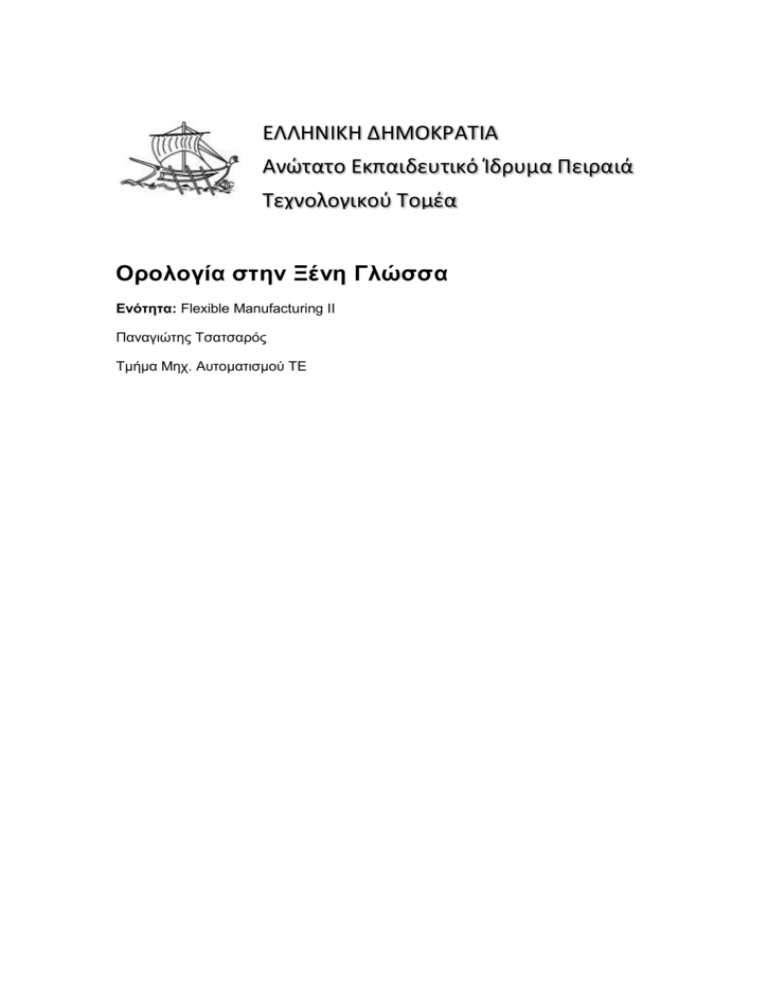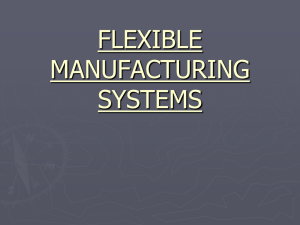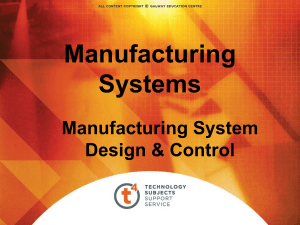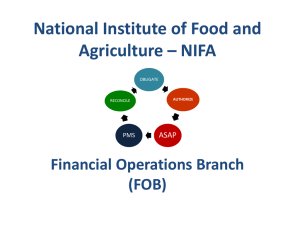Flexible Manufacturing II
advertisement

ΕΛΛΗΝΙΚΗ ΔΗΜΟΚΡΑΤΙΑ Ανώτατο Εκπαιδευτικό Ίδρυμα Πειραιά Τεχνολογικού Τομέα Ορολογία στην Ξένη Γλώσσα Ενότητα: Flexible Manufacturing II Παναγιώτης Τσατσαρός Τμήμα Μηχ. Αυτοματισμού ΤΕ Άδειες Χρήσης • Το παρόν εκπαιδευτικό υλικό υπόκειται σε άδειες χρήσης Creative Commons. • Για εκπαιδευτικό υλικό, όπως εικόνες, που υπόκειται σε άλλου τύπου άδειας χρήσης, η άδεια χρήσης αναφέρεται ρητώς. Χρηματοδότηση • Το παρόν εκπαιδευτικό υλικό έχει αναπτυχθεί στα πλαίσια του εκπαιδευτικού έργου του διδάσκοντα. • Το έργο «Ανοικτά Ακαδημαϊκά Μαθήματα στο Ανώτατο Εκπαιδευτικό Ίδρυμα Πειραιά Τεχνολογικού Τομέα» έχει χρηματοδοτήσει μόνο την αναδιαμόρφωση του εκπαιδευτικού υλικού. • Το έργο υλοποιείται στο πλαίσιο του Επιχειρησιακού Προγράμματος «Εκπαίδευση και Δια Βίου Μάθηση» και συγχρηματοδοτείται από την Ευρωπαϊκή Ένωση (Ευρωπαϊκό Κοινωνικό Ταμείο) και από εθνικούς πόρους. 2 1. Σκοποί ενότητας ................................................................................................ 4 2. Περιεχόμενα ενότητας........................................................................................ 4 3. Flexible Manufacturing II.................................................................................... 5 4. 3.1 The basics of flexible manufacturing ........................................................... 5 3.2 Part families ................................................................................................ 6 3.3 Flexible modules ......................................................................................... 6 3.4 Flexible cells. .............................................................................................. 6 3.5 Components of a system............................................................................. 7 3.6 Types of flexibility ........................................................................................ 7 3.7 Related automation systems. ...................................................................... 8 Computer Simulation ......................................................................................... 8 3 1. Σκοποί ενότητας The aims of this unit are to: Provide authentic text and vocabulary specific to the needs of students of Automation Engineering Encourage students to combine their knowledge of English with their technical knowledge Enable students to understand text coherence through the use of conjunctions and linking words Provide students with practice in context relevance 2. Περιεχόμενα ενότητας Flexible Manufacturing related to other disciplines Flexible Manufacturing: principles, technology and components Flexible Manufacturing Cells and Flexible Manufacturing Modules Types of flexibility of Flexible Manufacturing Systems and Subsystems Flexible Manufacturing Systems and related automation systems Computer Simulation in Flexible Manufacturing Systems 4 3. Flexible Manufacturing II Related to—and sometimes synonymous with—agile manufacturing, adaptable manufacturing, cellular manufacturing, computer-integrated manufacturing, flexible machining, and flexible automation, flexible manufacturing encompasses a diverse set of manufacturing principles and technologies with a few common goals: achieving a highly automated manufacturing process with rigorous computerized monitoring and management of quality and productivity making manufacturing operations readily scalable for different levels of output allowing customization and reconfiguration of manufacturing processes with minimal downtime and cost providing management with detailed and timely information about the manufacturing process enabling manufacturers to coordinate their work processes with those of their suppliers and customers to maximize efficiency and minimize costs ___________, flexible manufacturing systems (FMS) generally consist of a combination of computerized numerical control (CNC) machines, robots, selfdiagnostic systems, and a hierarchical information system. They may___________ include any number of other devices for material handling and other functions. These systems are designed to be easily reprogrammed or even regrouped with other devices___________ permit rapid and inexpensive changes in the manufacturing process, facilitating quick responses to market changes and allowing for so-called mass customization of products. FMS can___________ monitor, schedule, and route workflow to maximize efficiency and to avoid deadlocks ___________ component failures or backlogs on certain devices. 3.1 The basics of flexible manufacturing ___________each FMS is unique in configuration and process, an abstract description of overall operations in outline form is possible. ___________, numerical control programs and computer-aided process planning are utilized to develop the sequence of production steps for each machined part. ___________, based on inventory, orders, and computer simulations of how an FMS can run most economically, a schedule is established for parts that are going to be produced on that day. ___________, material and required tooling arc retrieved either automatically or manually from storage and loaded into the system. ___________ loaded, the FMS begins machining operations. ___________the process plan, robots, conveyors, and other automated material handling devices transport the workpiece between workstations. Should any tool break down during the production cycle, an FMS can reroute the workpiece to other tools within the system. 5 3.2 Part families Most FMS (or their subsystems) are designed to produce any number of related workpieces. ___________, the essential characteristics that constitute a workable "partfamily" are common shape, size, weight and tolerance range. ___________ members of a part family share many traits, usually a software-directed change is all an FMS requires to switch from producing one kind of part to another. 3.3 Flexible modules Workstations, or individual processing units, are a concept central to any discussion of FMS. A processing unit refers to the sum of operations performed within a particular factory area containing several pieces of process equipment meant to carry out individual or multiple operations on various products. ___________, different workstation distinctions mark the divide between two FMS subsystems—the flexible manufacturing module (FMM) and the flexible manufacturing cell (FMC). The module comprises a stand-alone numerically controlled machine tool (NCMT), automatic material handling device (such as a robot or automatic pallet changer) and an automated monitoring system to control for tool breakage, equipment depreciation, automatic measuring and related diagnostics. FMM constitute the first step in the automation of the loading and unloading of parts to and from an NCMT. For machining centers, automatic pallet changers make it possible for unmanned attended machining to occur for___________ six hours. 3.4 Flexible cells. The flexible manufacturing cell, ___________, comprises two or more machine tools which may or may not include NCMT. ___________ FMM. the FMC incorporates a material handling device (such as a robot) servicing several machine tools arranged in a circle or line. Automatic pallet changers are also used___________ automatic conveyor systems linking NCMT. ___________ an FMM, information flow to and from an FMC is integrated into a larger monitoring control system. FMC are less flexible than FMM. Usually FMC are applied to a "family," ___________some broader grouping of components----___________shafts within a prescribed size range. ___________each FMC is designed to meet the specialized requirements of different customers, standardization is not a universal feature. ___________, just the design phase requires considerable consultation and information exchange between the specific user and FMC supplier. It should be noted that early versions of FMC and FMS initially functioned below their anticipated performance level. Problems arose ___________the technical difficulties involved when linking product flows with different machines. ___________, demand for FMC is initially limited to a few large firms with enough financial clout to undertake the risky investment the systems represented. 6 3.5 Components of a system With the above subsystems in mind. FMS can be distinguished by the following characteristics: the flow of tools and parts between different machine groups is automated; material handling is mostly, but not exclusively, performed by automated guided vehicle systems (AGVS), and not, as ___________ FMC, industrial robots. This is explained by the fact that FMS consist of machining centers mostly involved with the production of, geometrically speaking, prismatic parts, while material handling robots work___________ computer numerically controlled (CNC) lathes that machine rotational parts. ___________ FMS also incorporate the use of conveyors and rail guided transport systems. And, ___________ their subsystems, FMS have a lower rate of labor utilization, higher labor productivity, and, ___________ higher capital productivity. FMS are usually equipped with a "hot standby" feature. This alludes to a computer control system comprising two computer units. Should one fail to operate, the other automatically kicks in to keep the FMS running. 3.6 Types of flexibility __________ joint characteristics, FMS and their subsystems share most, if not all, of the following to differing degrees: Machine flexibility—the ease of making the changes necessary to manufacture a specific set of part/product types. Process flexibility—the capacity to manufacture a given set of part/product types in a variety of ways, each possibly using different materials. Product flexibility—the systematically unique condition to change over to produce a new set of parts or products economically and quickly. Routing flexibility—the capability to cope with breakdowns and continue manufacturing a given set of part/product types using alternative routes. Volume flexibility—the ability to operate profitably across a range of different production volumes. Expansion flexibility—the potential to expand in a modular fashion. Production flexibility—the variable domain of part/product types that a system can produce. __________ all flexible systems are not equally versatile__________, manufacturers must determine which aspects of flexibility best serve business objectives__________ cost efficiency, speed, or the ability to rapidly implement product alterations. These objectives will dictate what kinds of tasks are best suited for flexible solutions and how much capital should be invested to develop each component of the FMS. 7 3.7 Related automation systems. __________ true FMS and their subsystems, are two other manufacturing concepts distinguished by their comparatively higher level of automation and lower level of flexibility. These are the flexible transfer line and fixed transfer line. Between these two systems and FMS a trade-οff, or "productivity dilemma," is said to exist. __________, the higher the level of automation, the greater the manufacturer efficiency__________ productivity and lower unit costs.__________ the efficiency advantage held by non-FMS related systems is said to be achieved__________ losing a certain degree of innovative flexibility. The flexible transfer line comprises workstations utilizing numerous automated general or special purpose machine tools joined by an automated workpiece flow system __________ line principle. The flexible transfer line is capable of simultaneously or sequentially machining different workpieces running along the same path. A fixed transfer line, _________, utilizes a number of special purpose machine tools ( __________ general ones) initially designed to produce one product only. After a considerable period of setup time __________, it can accommodate a different variant of the product, as in the case of different sized cylinder heads. Fill in the blanks above with the words given below. Some of the words must be used more than one times. According to (x2) / in comparison with / for instance Once / in general / such as As opposed to (x2) / next / in all respects Although / because / since (x2) Up to / in certain cases / similar to As a result / more specifically / indeed In terms of (x2) / to a far greater extent / accordingly In conjunction with(x2) / on the other hand / while Compared to / likewise / in order to Besides / due to (x2) / first In the case of / at the expense of / by contrast Though / following that / but In fact / also 4. Computer Simulation One of the __________ features of FMS is computer simulation. Thirty years after their introduction, a _________ of microcomputer-based simulation packages are available for simulation analysis. There are also many mainframe simulation packages now available in a microcomputer format. __________ their mainframe forerunners, microcomputer simulation packages are considered user-friendly and do 8 not require the __________ of highly skilled individuals. __________ developments introduced sophisticated color graphics in conjunction with several __________ in computer mainframes that allowed software developers to create even more complex programs that their user-friendly orientation. A __________ advance is the incorporation of animation techniques. In the opinion of Nigel Greenwood, had simulation analysis been available in the early days of FMS. their success __________ would have been greatly enhanced. Computer simulation exercises are performed to identify system __________ the utilization of fixed resources such as machine tools and variable resources such as operators, tools, and material __________. Utilization of resources is measured in terms of busy, idle, down, and __________ time. Simulation results then provide information to FMS designers about work in progress, production rates, and the __________ of equipment failure, all __________factors that determine how well a particular FMS works. When computer simulation packages first appeared, many experienced production engineers __________ their usefulness. Having been schooled in a "hard modeling" simulation background that used scale __________, pieces of paper, drawing pins, and the like to represent personnel and pallets, experienced engineers were skeptical of computer simulation modeling. The substantial advantages of computer simulation and the __________ of new engineers with computer trained backgrounds has __________ this initial skepticism. One critical limitation of computer simulation is that computer simulation modelers are unable to accurately __________ a specifically designed FMS facility, so that the possibility of an informational __________ between FMS project designers and simulators exists. Heightened communications between these two groups ensures that discrepancies arc minimized. It is also expected that __________ developments in microcomputer-based packages will help minimize discrepancies. In the evolution of an FMS during its multiphase design process, computer simulation is of great assistance. During the __________ design phase, if given a hypothetical array of workstation configurations, a computer simulation is able to determine their __________ throughput times to a high degree of reliability. It is also used to calculate initial financial analysis and to animate __________ configurations. During the detailed design phase, computer simulation makes it possible for suggested system improvements to be incorporated and tested in an FMS model to analyze their impact. Fill in the blanks with the words given below impact / respective / transporters / unlike / layout / conceptual presence / prospective / questioned / outstanding / alleviated bottlenecks / further / depict / blocked / advances / note-worthy plethora / retain / rate / relevant / discrepancy / influx subsequent 9









